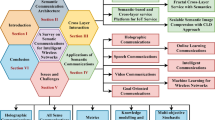Abstract
The IP Multimedia Subsystem (IMS) represents an attempt for networks convergence, allowing users of rich-content applications to communicate through any access network type. In the near future, IMS is expected to give operators and content providers the flexibility to exploit a multitude of new communication applications in a harmonized communication environment of heterogeneous IP networks. However, despite its merits, the standardization process of IMS networks is lagging behind, leaving harmonization issues of services provisioning, open. In this effort, main hindering factor is the existence of similar implementations customized per network technology. Particularly in what concerns the Intelligent Network (IN) services, these are provided in mobile networks by CAMEL (Customised Applications for Mobile networks Enhanced Logic) and in fixed networks by INAP (IN Application Part). With regard to this problem, the present work introduces a method for integrating into the context of IMS communications all types of IN logic that nowadays are available only in legacy networks. The key element of this method is a service interrogation logic, called IN-OAG (IN-Open Architecture Gateway), which can be integrated on the P-CSCF (Proxy-Call Service Control Function) component of IMS, as an enhancement for supporting IN interoperability. IN-OAG is dedicated to implementing interoperability between the core IMS and mobile, wireless or fixed networks. The functionality of the proposed architecture is shown through several example scenarios.
Similar content being viewed by others
References
Finkelstein, M., Garrahan, J., Shrader, D., & Weber, G. (2000). The future of the intelligent network. IEEE Communications Magazine, 38(6), 100–106.
Knightson, K., Morita, N., & Towle, T. (2005). NGN architecture: generic principles, functional architecture, and implementation. IEEE Communications Magazine, 43(10), 49–56.
3GPP, 3rd Generation Partnership Project; Technical Specification Group Services and System Aspects; IP Multimedia Subsystem (IMS) State 2 (Release 5), TS 23.228, Jun. 2003.
Bosse, J. (2002). Signaling in telecommunication networks. New York: Wiley.
Bhat, R., & Tait, D. (2001). Java in telecommunications: solutions for next generation networks (pp. 15–53). New York: Wiley.
Zuidweg, J., & Zuidweg, H. (2002). Next generation intelligent networks. Norwood: Artech House. ISBN 1580532632.
3GPP, 3rd Generation Partnership Project; Technical Specification Group Core Network; Customised Applications for Mobile network Enhanced Logic (CAMEL) Phase 4; CAMEL Application Part (CAP) specification (Release 6), TS 29.078, Jun. 2004.
Stretch, R. M., & Adams, P. M. (2005). Standards for intelligent networks. BT Technology Journal, 23(1), 154–159.
de Keijzer, J., Tait, D., & Goedman, R. (2000). JAIN: a new approach to services in communication networks. IEEE Communications Magazine, 38(1), 94–99.
Moerdijk, A. J., & Klostermann, L. (2003). Opening the networks with Parlay/OSA: standards and aspects behind the APIs. IEEE Network, 17(3), 58–64.
RFC 3261, SIP-Session Initiation Protocol. http://www.ietf.org/rfc/rfc3261.txt, IETF, Jun. 2002.
3GPP, 3rd Generation Partnership Project; Technical Specification Group Core Network and Terminals; Customised Applications for Mobile network Enhanced Logic (CAMEL) Phase 4; Stage 2; IM CN Interworking (Release 7), TS23.278, Mar. 2006.
3GPP, 3rd Generation Partnership Project; Technical Specification Group SA3; Access security for IP-based services (Release 7), TS 33.203, Dec. 2006.
Chiang, R. C. N., Sesmun, A., Foster, G., Young, M., & Baker, N. (2002). Transport of mobile application part Signaling over Internet protocol. IEEE Communications Magazine, 40(5), 124–128.
The FlexiNET Consortium, Deliverable 2.1: Requirements, Scenarios and Initial FlexiNET Architecture, Oct. 2004.
3GPP, 3rd Generation Partnership Project; Technical Specification Group Services and System Aspects; IP multimedia call control protocol based on Session Initiation Protocol (SIP) and Session Description Protocol (SDP); Stage 3, TS 24.229, Oct. 2006.
3GPP, 3rd Generation Partnership Project; Open Service Access (OSA) Application Programming Interface (API); TS 29.198-01; Part 1; Dec. 2000.
Author information
Authors and Affiliations
Corresponding author
Rights and permissions
About this article
Cite this article
Tompros, S.L., Vergados, D.D., Douligeris, C. et al. Provision of unified IN functionality in the context of IMS. Telecommun Syst 37, 191–201 (2008). https://doi.org/10.1007/s11235-008-9107-z
Published:
Issue Date:
DOI: https://doi.org/10.1007/s11235-008-9107-z




